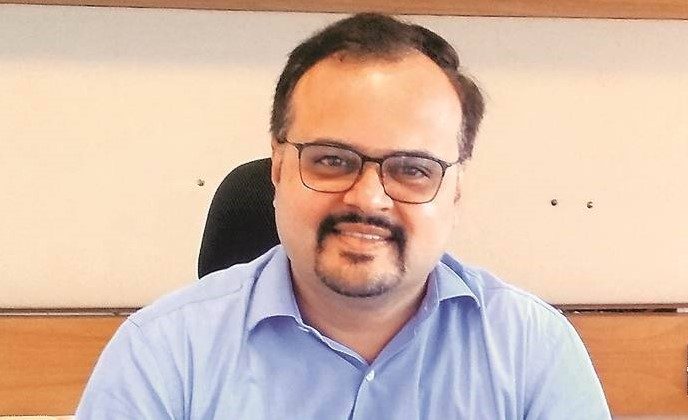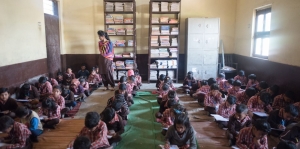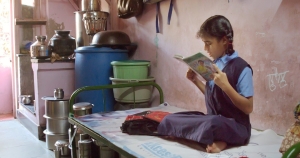With the Union Budget 2021-22 just around the corner, this edition of The EDge is dedicated to understanding implications of budgetary allocations on education reforms. CSF interviewed Dr Vinod R. Rao, the Secretary of the State Education Department (Primary and Secondary) in Gujarat, to deep-dive into how the state runs initiatives that enhance student learning, especially in early grades, while simultaneously managing finances

CSF: The current year has been quite challenging for school education since schools have now been closed for close to 8 months. Could you share how Gujarat has ensured continued learning at home for children in the midst of the pandemic? What, if any, have been the budgetary implications for ensuring home learning, and how has Gujarat funded for these unplanned expenses?
Dr Rao: The State Education Department pulled out all stops to ensure that education doesn’t get interrupted. We launched several transformative initiatives to ensure ‘Learning without Schooling’ in response to COVID-19. We relied heavily on EdTech and made use of all available resources while simultaneously exploring new ways to reach out to all students. We launched a Home Learning Program where we developed high-quality learning content for online and offline classes along with lesson plans. The content was published and made available to students using a wide array of mediums/platforms like DIKSHA, television, YouTube, WhatsApp, and Facebook. Our YouTube channel ‘Gujarat Virtual Shala’ alone has witnessed over 3 lakh subscriptions with over 6 million views.
Teachers held virtual classes using Microsoft Teams. We organised training and capacity-building workshops for teachers using DIKSHA; and Gujarat has the maximum number of teachers using DIKSHA for training purposes across India. Additionally, we ensured delivery of physical material like textbooks to the doorsteps of our students. These books were energised by QR codes which can be scanned and accessed by students on their devices.
We also partnered with Facebook, Microsoft, and Google to leverage them for teaching-learning. But this had no commercial implications. We used available budgets for these initiatives; nothing additional was required.
We launched a Home Learning Program where we developed high-quality teacher-learning material like presentations for online classes and lesson plans. The content was published and made available to students using a wide array of mediums/platforms like the television, YouTube, WhatsApp, and Facebook.
CSF: Do you think that the budget allocated to education (Centre + state) in Gujarat is sufficient for achieving learning outcomes in primary classes? What are some of the biggest challenges when it comes to utilising the budget for education reforms?
Dr Rao: The state allocates almost 19% of its budget towards education; so allocations per se is sufficient. The challenge lies in making judicious use of the allocations, and rationalising resources as best as possible.
A major portion of the budget goes into recurring expenses like paying salaries to teachers and other staff members, printing teacher-learning material, and getting civil work done like construction of new classrooms, repair and maintenance work, etc. Another major expense is the reimbursement to private schools for children admitted under RTE 12(1)(c). After accounting for all of these regular expenses, the state is still left with enough to introduce educational innovations and reforms if the funds are allocated intelligently and appropriately. I strongly believe that public money should be invested and spent judiciously, and that budgetary constraints lead to optimal utilisation. So, we pursue impactful, zero-budget initiatives. For instance, we rely on internal experts to design interventions. And we introduced the School Quality Accreditation Program where we selected 500 teachers after a robust process to be School Inspectors. These were extra teachers we roped in to carry out responsibilities outside of classroom instruction.
CSF: The NEP calls for public expenditure on education to increase to 6% of GDP. What do you see as some challenges to increased allocations to the education sector? What role do you think CSR and other international organisations can play in augmenting the funds allocated by the Centre and states?
Dr Rao: In my opinion, judging allocations based on the percentage of the GDP is not a very effective metric. A state with high GDP will have a huge budget at its disposal, and can easily allocate 6% for education. However, the question is, will the state be able to use the 6% constructively. There are many states which are unable to spend the entire amount allocated to them for education reforms. They allocate about 2% of their GDP, but manage to spend only 1-1.4%.
States with low GDP will face challenges in making 6% available for education. Such states can benefit immensely with support from CSR and international organisations. Even big states which struggle with effective planning and implementation due to capacity restrictions can use help. International organisations can guide these states on how to utilise the budgets and help in capacity-building. Gujarat’s World Bank & AIIB supported ‘Mission Schools of Excellence’, the World Bank’s STARS, and the ADB Project are great examples of how states can work in collaboration with multilateral institutions.
CSF: How does the state aim to address the learning deficit in foundational grades (1-3)? Do you think there is a need for a separate budget that aims to improve learning in foundational grades?
Dr Rao: Gujarat was one of the first few states to recognise the importance of Foundational Literacy and Numeracy (FLN) and initiate action of bridging learning gaps in early grades. We have planned interventions to improve FLN outcomes; designed assessments such that they do away with rote learning and encourage more meaningful learning; and figured out remediation and course correction activities that will help children. We also have a very active FLN task force which focuses solely on enhancing FLN outcomes in Grades 1-2.
Early this year, we also launched the Mission Schools of Excellence, an initiative that aims to help children achieve grade appropriate learning outcomes and improve their high-order thinking skills. This project has an FLN Cell that looks at strengthening basic reading with meaning and mathematics skills among children. In addition to holistic education programmes prioritising FLN, Gujarat will soon launch a FLN-focussed initiative which will receive dedicated funding.
We established quarterly learning goals, and conducted assessments to track if these goals were being met. This helped us understand children’s learning levels and teach them at their skill level.
CSF: What are some of the measures adopted by the state that have had maximum impact with minimal financial investment in foundational Grades (1-3)?
Dr Rao: We understand that acquisition of FLN skills are non-negotiable in early grades. Without being able to read simple sentences while simultaneously comprehending the meaning, and solve basic math problems by Grade 3, children tend to fall behind in higher grades. We need to get it right from the outset itself. Gujarat implemented the following few initiatives to ensure we’re on the right track.
- We implemented a School Readiness Programme for Grade 1 entrants. When children enrol in Grade 1, they are expected to have basic pre-literacy and pre-numeracy knowledge along with the cognitive skills to follow the curriculum. We rolled out this programme to bring children up to speed with things they should know to be able to succeed in a classroom environment. This includes things like their ability to pay attention in the class, interact with peers, follow instructions, hold a pencil, identify shapes and patterns, count numbers, etc. We provided workbooks to all students and scripted lesson plans for teachers to equip them the required resources for this program to succeed
- We undertook an exhaustive exercise to identify children eligible to study in Grade 1 and enrol them in schools
- We established quarterly learning goals, and conducted assessments to track if these goals were being met. This helped us understand children’s learning levels and teach them at their skill level. For example, one of the goals included Oral Reading Fluency (ORF). This refers to a child’s ability to accurately read a specific number of words in a minute with meaning.



